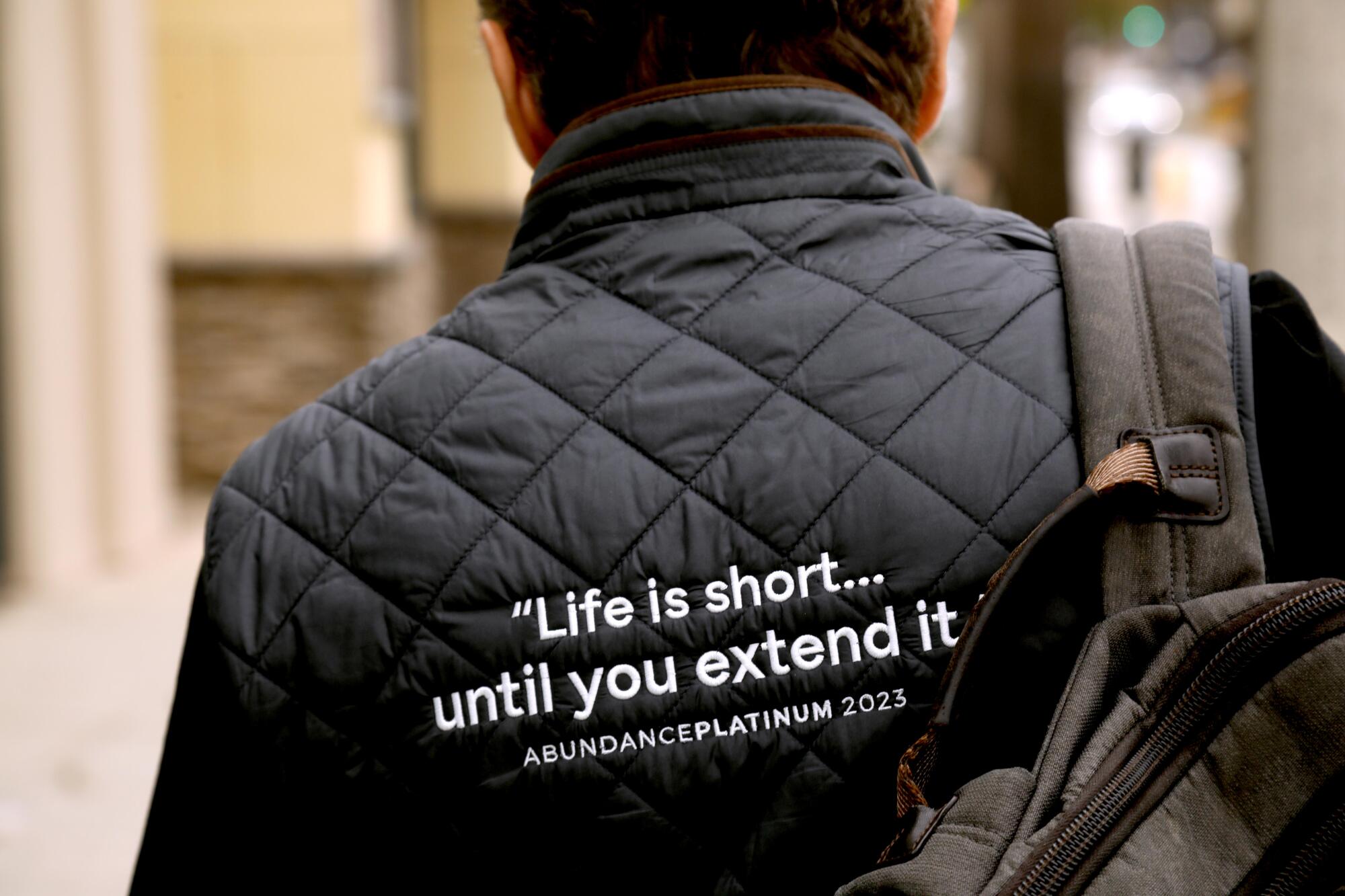
Peter Diamandis, a week away from turning 63, bounds out of a Starbucks on a recent morning with a cup of decaf, his daily medley of 70 supplement capsules in his pocket and, tucked under his left arm, a box of freshly deposited poop.
The serial entrepreneur is in the standard uniform of serial entrepreneurs: jeans, sneakers, fitted black T-shirt, Apple Watch, Oura Ring and puffer vest, the back of which says, “Life is short … until you extend it.”
“I woke up at 6. I meditated for 15 minutes. I took fecal samples — I hate to say that, unappetizing, sorry,” Diamandis says as he makes his way up Wilshire Boulevard. “Went through my dental protocol. Did push-ups and sit-ups and squats. And then came here.”
“Here” is a sixth-floor doctor’s office in Santa Monica, where the XPrize founder has been coming every few weeks to undergo therapeutic plasma exchange. The $7,500 procedure involves removing blood, running it through a machine to separate out the plasma and replace it with albumin and saline, and then returning the replenished blood to the body.

“I’m basically giving myself an oil change,” Diamandis says once he’s hooked up, a large-gauge needle poking out of each arm, deep red blood flowing in both directions. He’ll be here for the next three hours.
Therapeutic plasma exchange is typically done to treat a number of diseases, but as far as Diamandis knows — and he has gone to great lengths to know — he is in excellent health. Instead, he’s using it prophylactically as part of the $120,000 he spends every year to live as long as possible.
This is the early days where I consider myself in part a chief guinea pig. I don’t feel I’m taking a very high risk, so I find very little downside and, I believe, reasonable upside.
— Peter Diamandis
He is hardly alone in the pursuit. The eternal quest to delay or even conquer death has reached new levels of fascination in recent years, spurred by a growing number of researchers studying the aging process and major investments in the field from billionaires including Jeff Bezos, Larry Page, Sergey Brin, Peter Thiel and Sam Altman.
The anti-aging movement has also gotten a boost — and a fair share of ridicule — from extreme tales of rich immortality biohackers such as Los Angeles multimillionaire Bryan Johnson, who claims that death is no longer inevitable. The 46-year-old tech entrepreneur follows an audacious $2-million-a-year “don’t die” plan — downing shots of olive oil and protein-packed “nutty pudding” and obsessively measuring his bodily functions down to the duration of his nighttime erections — in an attempt to turn back his biological clock.

Longevity is the medical frontier and lifestyle fad of the moment, but it remains a hotly debated and controversial topic within the scientific community.
Although human lifespan has more than doubled since the early 1900s — life expectancy at birth is now about 73 years globally — it is unclear whether any of the buzzy treatments widely marketed today will amount to a meaningful increase in quantity and quality of life down the line. Skeptics criticize much of the remedies being peddled as scientifically unproven and nothing more than hype and false hope.
There are also moral questions at play and a basic philosophical disagreement over whether aging should be considered a disease that can be reversed — and, if so, what that even means. Without aging being defined as an illness, longevity treatments face a murky regulatory path with the FDA.
“The promise and the potential are transformative, and I really do think we’re going to see a revolution in health because of longevity medicine,” said Mitchell Lee, a molecular geneticist and chief executive of Ora Biomedical, a biotech firm focused on developing therapies to help people live longer, healthier lives. “The cold water to splash on the face is we are not there yet. We don’t know of any single intervention that improves healthy lifespan, like what we’ve seen in the lab, in humans.”
That hasn’t stopped longevity influencers and enthusiasts from experimenting, especially those with the money and time needed to immerse themselves in the booming market of treatments, superfoods, pills and powders, concierge doctors and med spas, IV nutrition drips, biometric screenings and strict regimens that they believe will extend their lifespans and, crucially, their healthspans.
“No one wants to be 150 drooling in a wheelchair,” says Diamandis, whose extensive self-testing includes sitting in front of a 4-foot red-light panel every morning in his Santa Monica home (he believes the therapy improves skin health and reduces inflammation in the body) and off-label usage of rapamycin, an immunosuppressant drug that has been shown to slow cellular aging in mice and other animals.

“This is the early days where I consider myself in part a chief guinea pig,” he says. “I don’t feel I’m taking a very high risk, so I find very little downside and, I believe, reasonable upside.”
How long would he like to live? “One hundred is a lowball offer,” he told a packed audience during a longevity roundtable at the Milken Institute Global Conference earlier in the week. “Let’s add a few multipliers on that.”
Diamandis has become a prominent spokesman for the industry and an investor in it, directing a third of his $600-million venture fund, Santa Monica-based Bold Capital Partners, into longevity and other health-related startups.
He says he is aware that he shoulders “significant responsibility” as he works to turn a profit in the emerging longevity field. He says he consults with physicians and a medical advisory board to ensure that what is being presented to customers is “peer-reviewed science with rigor and reproducibility.”
“There are a lot of dubious treatments,” he says. “If it’s anything that’s being delivered to humans, we really dive in and evaluate to make sure they’ve got the appropriate FDA approvals and that there is strong published science. Because I do feel an obligation.”
Patients taking Ozempic and other trendy injectables are going under the knife to correct the side effects of rapid weight loss, which include sagging skin, hollow cheeks and an aged appearance.
Diamandis first became intrigued by super-long living when he was a medical student at Harvard and learned about the bowhead whale, which scientists estimate can live to more than 200 years, and the Greenland shark, with a lifespan believed to be as much as 500 years. (Although he graduated from med school, he didn’t pursue a career as a physician.)
His reasons for wanting to push the boundaries of his existence are both personal and otherworldly.
He had children for the first time at 50 — twin sons who are now 12 — and he wants as much time with them as he can get (and, eventually, with their children and their grandchildren).
And as a technologist who has started more than 25 companies, most of them in the space, health-tech and education industries, he sees humans making enormous leaps in the near future and doesn’t want to miss out. In particular, he believes we are getting close to “longevity escape velocity,” a theory embraced by immortalists that posits that, at some point, scientific breakthroughs will extend a person’s remaining life expectancy by more than a year for every year that they stay alive.

“Going to the moon, going to the asteroids, seeing humanity spread itself through the solar system — I want to witness and participate,” he says over the gentle whirring of the plasma exchange machine as a team of doctors and nurses monitor his vitals. Nearby, a translucent bag hanging from a metal pole steadily fills with a cloudy amber-hued liquid — his “toxic soup” of discarded plasma, Dr. Sheldon Jordan says.
Diamandis is the first to acknowledge his live-long goal is not altogether altruistic. Longevity, he said over lunch at the Casa Del Mar hotel in Santa Monica in April (grilled fish, steamed veggies, shot of olive oil at the end), is “the biggest business opportunity on the planet.”
And it’s growing at a rapid pace. The longevity and anti-senescence therapy market totaled $27.1 billion last year and is predicted to reach $44.9 billion by 2031, according to market research firm InsightAce Analytic.

A separate analysis by Deloitte found that the top 50 longevity-focused companies raised more than $1 billion in venture funding as of 2020 and noted that “we are at the cusp of a new multibillion-dollar longevity industry.”
The firm added a caveat: “Success has been uneven. Despite exponential gains early on, the extension of lifespan has largely leveled off in the past 30 years.”
In the last decade, Diamandis has shifted his entrepreneurial endeavors and investments to focus primarily on extending healthspan.
His latest XPrize, announced in November, is a seven-year global incentive competition that will award $101 million in prize money — the largest purse to date — to the team that best develops a therapeutic treatment able to reverse aging by 20 years in cognition, muscle and immune function.
He is co-founder of biotech firms including Celularity, a regenerative and cellular medicine company, as well as several consumer-facing ventures.

Twice a year, he leads a “Platinum Longevity Trip” that links 40 ultra-high-net-worth individuals with top scientists, chief executives, startup founders and laboratories in the age-reversal field. For $70,000, promotional materials promise, participants will “gain unparalleled access” to the latest treatments and clinical trials and learn about research into tissue and organ regeneration, epigenetic reprogramming, neurocognitive regeneration and AI drug discovery.
The “five-day, five-star longevity deep-dive” includes private air travel and resort lodging; upcoming trips this fall in San Francisco and San Diego are already more than half full.
He also runs Abundance360, a year-round executive program that culminates in a five-day summit held at Terranea Resort in Rancho Palos Verdes. This year’s gathering featured a day devoted to longevity, with members paying $23,500 to $45,000 to attend in person.
If you’ve been fortunate enough to make $100 million or more, you want to do whatever you can to live forever.
— Michael Cole, managing director of R360, a members-only organization for centimillionaires
Other groups catering to the uber-wealthy are assembling their own anti-aging programs. Last year R360, an exclusive organization for centimillionaires, led a longevity trip to the Harvard laboratory of David Sinclair, a genetics professor and leading researcher on reversing the aging process at a cellular level. This July members will visit the Buck Institute for Research on Aging in Novato.
“If you’ve been fortunate enough to make $100 million or more, you want to do whatever you can to live forever,” said Michael Cole, managing director of R360. Since the organization was founded three years ago, its health, wellness and longevity subgroup has been one of the most popular offerings among its 125 members, whose average net worth is $400 million.
Many members, Cole said, are also traveling abroad for anti-aging treatments not available in the U.S.
Stem cell therapy in particular has been a driver of medical tourism to Panama, Antigua and Croatia, said Jonathan Edelheit, chief executive of the Medical Tourism Assn. The controversial procedure, which purports to rejuvenate the body by regenerating tissues, improve organ function and reduce disease risk, can cost tens of thousands of dollars per session.
“We’re witnessing a surge in the number of stem cell clinics, and this trend is likely to accelerate significantly in the next 12 to 24 months,” Edelheit said. “You’re going to see people with money diving into this even more.”
The FDA gave stem cell clinics three years to comply with its rules. The number of illegal clinics exploded.
Diamandis has also gotten into the clinic business, though not for stem cells (he believes there are benefits to the trendy therapy popularized by athletes and celebrities, but has stayed away after developing an inflammatory reaction a few weeks after trying stem cell joint injections).
Four years ago he started Fountain Life, which bills itself as a “country club for precision diagnostics,” with William Kapp, who is CEO, life coach Tony Robbins and others.
The high-end chain of medical centers is taking a proactive approach to healthcare. Fifteen hundred people are paying for the top-tier membership, which costs $19,500 a year and comes with a dedicated healthcare team led by a “longevity physician.”
The goal is to predict and catch diseases before they manifest by putting customers through an expansive battery of tests including MRI and CT imaging; whole genome sequencing; bone density scans; toxin, function and performance testing; and other biomarker checks.
There are four Fountain Life centers so far, in Florida, New York and Texas, with plans underway to launch dozens in major cities around the world.
Next year Diamandis will open a 12,000-square-foot Century City location with hospitality mogul Sam Nazarian, who signed on as a partner after a visit to one of the centers last fall revealed that he had a 7.5-millimeter brain aneurysm. Fountain Life’s medical team referred the 48-year-old to a surgeon who removed it a month later.

While Diamandis likes to say that 8 billion people all face the same disease of aging, what he’s selling is a luxury currently out of reach for most people. He insists costs will come down as AI, biotech and imaging technologies improve.
“When technologies don’t work well, they’re paid for by the rich, who experiment,” he says. “When they finally work really well, they’re in mass production and available to everybody.”
And much of what he’s advocating for, he notes, is free.
During his many conference appearances, in the books he’s written, and on his blog and podcast, he pushes well-established healthy lifestyle practices first and foremost: getting enough sleep (ideally seven to eight hours a night); a balanced diet high on protein and low on carbs; cutting down or eliminating sugar (“a poison,” he says); and a consistent exercise routine that prioritizes building muscle mass. It also helps, he says, to have an optimistic mindset.
Suddenly, he stops mid-sentence.
“Hey guys, could you slow it down a tiny bit? I’m just feeling a little lightheaded.”
Moments before, Diamandis had asked to speed up the rate that his blood was being processed because he was in a hurry to get home and tape his podcast. He also needs to find a post office to send his box of poop, which at the moment is being used as a coaster for his Starbucks cup, to a lab for microbiome testing.
A nurse brings him a carton of apple juice and a bag of Cheez-Its. He consumes both, not above sugars and processed snacks in this moment, but starts to turn pale. His heart rate drops to 45 beats per minute.

Soon Diamandis is laid flat on his back, head lowered, feet elevated. The plasma machine is switched off with eight minutes left to go.
He recovers quickly after an extra infusion of saline and is on his feet within 20 minutes, proudly holding up three bulging bags of plasma.
A few days later, he celebrates his 63rd birthday with his family (and one indulgent bite of chocolate cake) and shares a message with his quarter-million followers on X:
“Live long enough to live forever.”
More to Read
Subscriber Exclusive Alert
If you're an L.A. Times subscriber, you can sign up to get alerts about early or entirely exclusive content.
You may occasionally receive promotional content from the Los Angeles Times.









